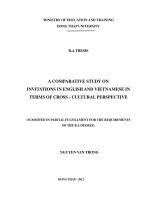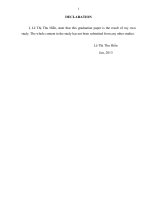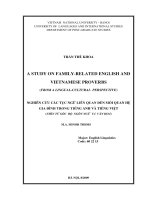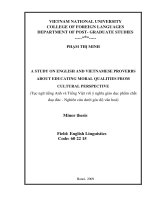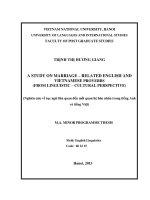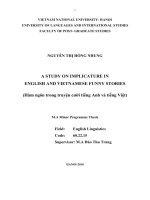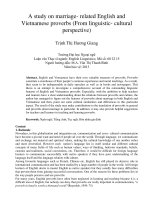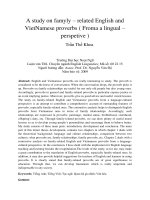A study on famyly – related English and VietNamese proverbs ( Froma a lingual – perspetive )
Bạn đang xem bản rút gọn của tài liệu. Xem và tải ngay bản đầy đủ của tài liệu tại đây (316.95 KB, 9 trang )
A study on famyly – related English and
VietNamese proverbs ( Froma a lingual –
perspetive )
Trần Thế Khoa
Trường Đại học Noại Ngữ
Luận văn ThS. Chuyên ngành:English Linguistics; Mã số: 60 22 15
Người hướng dẫn: Assoc. Prof. Dr. Nguyễn Văn Độ
Năm bảo vệ: 2009
Abstract: English and Vietnamese proverbs are really interesting to study. The proverb is
considered to be the horse of conversation. When the conversation drops, the proverb picks it
up. Proverbs on family relationships are useful for not only old people but also young ones.
Accordingly, proverbs in general and family-related proverbs in particular express justice or
an event implying justice. Moreover, proverbs give us good advice and useful moral lessons.
The study on family-related English and Vietnamese proverbs from a language-cultural
perspective is an attempt to contribute a comprehensive account of outstanding features of
proverbs, especially family-related ones. The contrastive analysis helps to distinguish English
proverbs from Vietnamese ones in terms of family relationships. Accordingly, such
relationships are expressed in proverbs: parentage, marital status, brotherhood, sisterhood,
offspring’s duty, etc. Through family-related proverbs, we can draw plenty of useful moral
lessons so as to develop young people’s personalities and encourage them to behave better.
My study consists of three main parts: introduction, development and conclusion. The main
part of this minor thesis, development, contains two chapters in which chapter 1 deals with
the theoretical background: language and culture relationships, comparison between two
cultures, what proverbs are, family relationships, family proverbs, etc. Chapter 2 deals with a
contrastive analysis on family-related English and Vietnamese proverbs from a language-
cultural perspective. In the conclusion, I have dealt with the implication for English language
teaching and learning besides the recapitulation.The result of the study, as for me, may make
a great contribution to the translation of English proverbs, especially family-related ones. In
addition, it may also provide helpful suggestions for teachers of English and learners in using
proverbs. It is clearly stated that family-related proverbs are of great significance to
education. Through that, we can develop humanism which is really important and
indispensable in any society.
Keywords: Tiếng Anh; Tiếng Việt; Tục ngữ; Quan hệ gia đình; Văn hóa.
Content:
iv
TABLE OF CONTENTS
DECLARATION……………………………………………………………………….i
ACKNOWLEDGEMENTS…………………………………………………………….ii
ABSTRACT……………………………………………………………………………iii
INTRODUCTION
1. Rationale…………………………………………………………………………….1
2. Aims of the Study……………………………………………… ………………….2
3. Scopes of the Study…………………………………………… ……………… 2
4. Methods of the Study…………………………………………….…………………3
5. Design of the Study……………………………………… ……………………… 3
DEVELOPMENT
CHAPTER 1: THEORETICAL BACKGROUND
1.1. The Relationship between Language and Culture
1.1.1. Culture……………………………………………………………………………4
1.1.2. Language…………………………………………………………………………4
1.1.3. The Relationship between Language and Culture…………….……………… 5
1.2. Comparison between Two Cultures……………………………………….……….6
1.2.1. Same Form, Different Meaning
1.2.2. Same Meaning, Different Form
1.2.3. Same Form, Same Meaning, Different Distribution
1.3. Definitions of Proverbs and Family Proverbs
1.3.1. Definitions of Proverbs………………………………………………………… 8
1.3.2. Family Proverbs………………………………………………………………….9
1.4. Definitions of Idioms……………………….…………………………………… .10
1.5. Proverbs versus Idioms, Sayings, Conventional Phrases and Phrasal Verbs…… 11
1.6. Main Features of Proverbs from a Language-Cultural Perspective
1.6.1. National Features……………………………………………………………… 12
1.6.2. Meanings of Proverbs………………………………………………….……… 13
1.6.2.1. Synecdoche
1.6.2.2. Metaphor
1.6.3. Rhyming Words in Proverbs……………………………………………………13
v
1.6.4. Contrary Proverbs…………………………………………………………… 13
1.7. Summary……………………………………………………………… ……… 13
CHAPTER 2: TENTATIVE CLASSIFICATION AND COMPARISON OF FAMILY-
RELATED ENGLISH AND VIETNAMESE PROVERBS
2.1. Tentative Classification of Family-Related English and Vietnamese Proverbs 14
2.2. Comparison of Family-Related English and Vietnamese Proverbs
2.2.1. Attitudes towards Women………………………………………… …….15
2.2.1.1. Attitudes towards Women in Family-Related Vietnamese Proverbs
2.2.1.2. Attitudes towards Women in Family-Related English Proverbs
2.2.2. Love ……………………………………………………………………….18
2.2.2.1. Love in Family-Related Vietnamese Proverbs……………………… 18
2.2.2.2. Love in Family-Related English Proverbs………………… ……….19
2.2.3. Marriage
2.2.3.1. Marriage in Family-Related Vietnamese Proverbs…………… ……19
2.2.3.2. Marriage in Family-Related English Proverbs……………………… 21
2.2.4. Choosing Mates
2.2.4.1. Choosing Mates in Family-Related Vietnamese Proverbs……………22
2.2.4.2. Choosing Mates in Family-Related English Proverbs……………… 23
2.2.5. Husband-Wife Relationship……………………………………………….24
2.2.5.1. Husband-Wife Relationship in Family-Related Vietnamese Proverbs
2.2.5.2. Husband-Wife Relationship in Family-Related English Proverbs
2.2.6. Divorce, Remarriage and Polygamy……………………………… …….26
2.2.6.1. Divorce, Remarriage and Polygamy in Family-Related Vietnamese
Proverbs
2.2.6.2. Divorce, Remarriage and Polygamy in Family-Related English
Proverbs
2.2.7. Parentage……………………………………………………….………….28
2.2.7.1. Parents-Offspring Relationship in Family-Related Vietnamese Proverbs
2.2.7.2. Parents-Offspring Relationship in Family-Related English Proverbs
2.2.7.3. Parents’ Attitudes towards Offspring
2.2.7.4. Offspring’s Duties towards Parents
vi
2.2.8. Brotherhood and Sisterhood, and the Relationship between Mother-in-law
and Daughter-in-law……………………………………………………….31
2.2.8.1. Brotherhood and Sisterhood
2.2.8.2. Mother-in-law and Daughter-in-law Relationship
2.2.9. General Rules on Behaviours in British and Vietnamese Societies……… 33
2.3. Summary………………………………………………………………………….35
CONCLUSION
1. Recapitulation……………………………………………………………………….37
2. Implication of English and Vietnamese Proverbs for English Language Teaching and
Learning………………………………………………………………………….…….38
3. Suggestions for Further Studies…………………………………………… …… 39
REFERENCES………………………………………………………… ……………40
APPENDIX I
1
Introduction
1. Rationale
We are living in an era of globalization and integration. English, an international
language has become a very necessary means of communication and cross-communication
has become a pivotal demand for people the world over. English may be considered to be
the language of dancing since dancing is a language and you can speak with anyone.
Through language, people can express their opinions and exchange their ideas. Moreover,
they can exchange their material and spiritual values making the cultural knowledge of one
another richer and more diversified. Nevertheless, in each language there exist similar and
different cultural concepts on many aspects of life such as customs, traditions, social
conventions, human values, attitudes, behaviours, etc. How can a foreign language learner
communicate successfully with native speakers if they have poor understanding of the
language itself and the language related to culture.
Through proverbs, each person knows the other’s point of view and ways of thinking.
Moreover, we understand one another via customs, traditions, lifestyles, etc. We become
friendly as a result. Dr. Denis Brutus, a Literature professor at the University of
Pittsburgh, the USA, specified and extended the reality of the research of proverbs. He
said, “Through proverbs, I know your points of view, the attitudes of your ancestors. Each
time I know a new Vietnamese proverb, I become Vietnamese a little. I believe when we
know all proverbs of each other, we are brothers.” Somalian people said, “Proverbs put
spice into speech.” Yobura people in South Africa consider the proverb to be an animal
which nods its head when climbing uphill. They said, “The proverb is the horse of
conversation, when the conversation drops, the proverb picks it up”. Vietnamese people
regard the proverb as a pearl of academic thinking or a twinkling mist in literature.
In Vietnam, more and more people are eager to learn English and the need for learning
English is becoming very urgent. Most of the learners complain about the difficulties that
prevent them from succeeding in conversations. One of the main reasons is that they are
not good enough at perceiving and using idioms, especially proverbs.
The usage of proverbs is to express ideas in a figurative way, draw good lessons via
them and bring vividness and richness to the speaker’s conversation. If a speaker uses
proverbs skillfully, he/she can establish a good communicative relationship. In terms of
2
teaching English, lessons will be more interesting and effective if the teacher knows how
to apply proverbs to designing different activities in an English class: quizzes, games, role-
play, etc.
Moreover, family-related English and Vietnamese proverbs interest me most because
via these proverbs, I can draw very good lessons and know how to behave and treat others.
Each family is a social cell. We will have a fair society if all the families are values-
oriented. Moreover, family relationships play a very important role in educating children,
the future generation.
For the above-mentioned reasons, I have decided to choose this theme for my minor
thesis.
2. Aims of the Study
- To find out the cultural features in family relationships in British and Vietnamese
societies via English and Vietnamese proverbs (norms and values of culture, attitudes,
behaviours and ways of denotation or emotional expression, etc.)
- To find out the interesting things and the core, elegance, vividness and meaningfulness of
family-related English and Vietnamese proverbs via which significant educational lessons
will be highlighted and we can absorb the beautiful elegance and keep continuing the
cultural lines
- To apply family-related English and Vietnamese proverbs to teaching and learning both
English and Vietnamese for Vietnamese people and foreigners, to create interesting and
effective lessons and to form moral norms so as to educate students to become good
citizens
- To contrast the beauty, essence and elegance of family-related English and Vietnamese
proverbs and their usage.
3. Scopes of the Study
Proverbs are plentiful in both English and Vietnamese. Therefore, it is impossible
for the author to carry out an all-rounded study on them. Only family-related proverbs are
selected and a comparison between English and Vietnamese is made to distinguish one
from the other.
3
In this study, only semantic features of family-related English and Vietnamese
proverbs are discussed; cultural features are analyzed, not syntactic ones.
All English and Vietnamese proverbs are collected from dictionaries, books and the
Internet. Hence, this research does not cover all family-related English and Vietnamese
proverbs, just those of common use (more than 200 Vietnamese proverbs and about 200
English proverbs).
4. Methods of the Study
Contrastive Analysis is the main research approach used in my M.A. minor thesis.
Quantitative and qualitative methods are used. By virtue of the quantitative method, data
have been collected for the study including both English and Vietnamese proverbs
denoting family relationships. The qualitative method is applied to describe and analyze
the data of the study. Using statistics and deduction can help the author of this minor thesis
to improve his teaching. This can be applied to English teaching and learning at Quang
Ninh Center for Continuing Education and Cadre Training.
5. Design of the Study
This minor thesis consists of three main parts. In addition to the Introduction and
Conclusion, the study is organized around two chapters.
The Introduction raises the issue of English and Vietnamese proverbs in family setting.
Chapter 1 deals with the relationship between language and culture, the comparison
between two cultures, several definitions of proverbs, main features of proverbs, the
differences among proverbs, idioms, sayings, conventional phrases and phrasal verbs.
Chapter 2 is concerned with the classification and comparison between English and
Vietnamese proverbs within family setting.
The Conclusion sums up the main issues discussed in the thesis. The author also raises
his own opinion on the topic and suggests several ideas for further studies.
40
References
In English
1. Asher, R.E. (1994), The Encyclopedia of Language and Linguistics, Pergamon Press,
London.
2. Claire K. (1998), Language and Culture, Oxford University Press.
3. Diep, Doan Ngoc. (2007), A Study on Structural and Semantic Features on English
Idioms of Anger in Comparison with Vietnamese Equivalents, M.A. Minor Thesis,
Vietnam National University, Hanoi.
4. Fishman, J.A. (1991), Language, Culture and Communication, New York.
5. Jackson, H. and Amvela, E.Z. (1998), Words, Meaning and Vocabulary, Cassell.
6. Lyons, J. (1985), Linguistics Semantics: An Introduction, Cambridge University Press.
7. Mieder, W. (1993), Proverbs Are out of Season, Oxford university Press, London.
8. Mieder, W. (1985), The Prentice Hall Encyclopedia of World Proverbs, Prentice Hall,
London.
9. Norrick, N.R. (1989), Proverbial Linguistics: Linguistic Perspective on Proverbs, The
University of Trier Press.
10. Norrick, N.R. (1985), Trends in Linguistics: How Proverbs Mean, Mouton Press,
Amsterdam.
11. Page, M. & Washington, N. (1987), Family Proverbs and Value Transmission of Single
Black Mothers, Journal of Social Psychology.
12. Palmer, F.R. (1990), Semantics, Cambridge University Press.
13. Paster, A.B. & Toldson, I.L. (1982), Roots of Soul: The Psychology of Black
Expressiveness, Garden City, New York, Anchor Press/Doubleday.
14. Robert, L. (1988), Linguistics across Cultures, The University of Michigan Press.
15. Robins, R.H. (1989), General Linguistics, London and New York: Longman
16. Seidl and Mc Mordie (1988), English Idioms and How to Use Them, Oxford University
Press.
17. Simpson, J. (1993), The Concise Oxford Dictionary of Proverbs, Oxford University
Press.
41
18. Stone, E. (1988), How Family Stories Shape Us, Glamour.
19. Thuy, Vu Thi (2007), English Idioms about Human Characteristics through the Images
of Animals, M.A. Minor Thesis, Vietnam National University, Hanoi.
20. Tu, Dao Thanh (2007), Idiomatic Expressions Containing the Word “Dog” in English
and Vietnamese, M.A. Minor Thesis, Vietnam National University, Hanoi.
21. Vera, R.J. (1994), Aging Families and Use of Proverbs for Values Enrichment, The
Haworth Press, Inc., New York – London – Norwood.
In Vietnamese
22. Diên, Chu Xuân (1993), Tục ngữ Việt Nam, Nxb Khoa học xã hội, Hà Nội.
23. Dự, Nguyễn Hữu & Dương, Nguyễn Trùng (2003), Tục ngữ Anh - Việt, Việt – Anh
(English-Vietnamese and Vietnamese-English Proverbs), Nxb tổng hợp Đồng Nai.
24. Khanh, Nhuệ (2006), Tục ngữ Việt Nam, Nxb Hà Nội.
25. Kính, Nguyễn Xuân (1995), Tục ngữ Việt Nam, Nxb Văn hoá, Hà Nội.
26. Lân, Mã Giáng (1999), Tục ngữ, Ca dao Việt Nam, Nxb Giáo dục.
27. Liên, Phan Ngọc (1992), Cách ngôn, Tục ngữ về Đạo đức, Nxb Giáo dục, Hà Nội.
28. Mười, Nguyễn Văn (1996), Ngôn ngữ với việc phản ánh các yếu tố Văn hoá và Nhân
sinh quan (thông qua Tục ngữ Việt – Anh), Luận án Tiến sỹ, Đại học Quốc gia Hà Nội.
29. Ngọc, Nguyễn Văn (1991), Tục ngữ Phong dao Việt Nam, Nxb TP Hồ Chí Minh.
30. Phan, Vũ Ngọc (1992), Tục ngữ, Ca dao, Dân ca Việt Nam, Hội Nghiên cứu và Giảng
dạy Văn học TP Hồ Chí Minh.
31. Thu, Phương (1998), Ca dao, Tục ngữ Việt Nam, Nxb Thanh niên.
32. Thường, Trần Mạnh (1996), Tục ngữ, Ca dao Việt Nam, Nxb Văn hóa dân tộc, Hà Nội.
33. Tường, Vũ Mạnh (1998), Thành ngữ & Tục ngữ tiếng Anh (The Phrase & Proverb in
English) – Song ngữ, Nxb Hà Nội.
on the internet
34.
35.
36.
37.
38.

